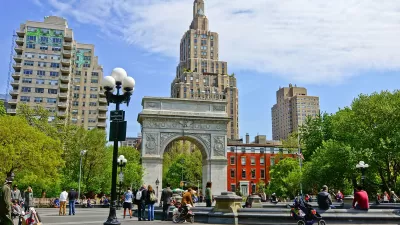In the aftermath of the Boston Marathon bombings, Eric Jaffe explores how cash-strapped cities will handle terrorism. "The short answer is public surveillance cameras. The long answer is smarter public surveillance cameras."
Jaffe reports from the New York Ideas festival, where NYPD Commissioner Ray Kelly explained how New York City has managed to maintain vigilent in combating terrorism despite having 6,000 less officers than it did a decade ago. "[A]n intricate system of cameras and license-plate readers," which covers Lower Manhattan and is being expanded to midtown and other "vulnerable" parts of the city, has been integral to their efforts.
"Part of what makes this strategy so efficient, despite a reduction in the size of the police force, is that cameras are handling more of the workload on their own," says Jaffe. "Analytics enable the cameras to see something and say something, if you will: they can determine if a package has been left in a particular spot for a long period of time, for instance, and track back through files to find a person wearing a certain color shirt."
However, as Sean Gallagher explains in Ars Technica, technology (and facial recognition software specifically) clearly failed in the search for the Boston bombing suspects. "Under the best circumstances, facial recognition can be extremely accurate, returning the right person as a potential match more than 99 percent of the time with ideal conditions," he says. "But to get that level of accuracy almost always requires some skilled guidance from humans, plus some up-front work to get a good image." Let's just hope those skilled humans aren't being furloughed when they're needed.
FULL STORY: How Cash-Strapped Cities Will Handle Terrorism

Study: Maui’s Plan to Convert Vacation Rentals to Long-Term Housing Could Cause Nearly $1 Billion Economic Loss
The plan would reduce visitor accommodation by 25,% resulting in 1,900 jobs lost.

North Texas Transit Leaders Tout Benefits of TOD for Growing Region
At a summit focused on transit-oriented development, policymakers discussed how North Texas’ expanded light rail system can serve as a tool for economic growth.

Using Old Oil and Gas Wells for Green Energy Storage
Penn State researchers have found that repurposing abandoned oil and gas wells for geothermal-assisted compressed-air energy storage can boost efficiency, reduce environmental risks, and support clean energy and job transitions.

San Mateo Formally Opposes Freeway Project
The city council will send a letter to Caltrans urging the agency to reconsider a plan to expand the 101 through the city of San Mateo.

A Bronx Community Fights to Have its Voice Heard
After organizing and giving input for decades, the community around the Kingsbridge Armory might actually see it redeveloped — and they want to continue to have a say in how it goes.

Houston Mayor Promises Dedicated Austin Street Bike Lane After Public Backlash
Although the one-way bike lane won’t be protected by physical barriers, the proposal is an improvement over the mayor’s initial plan to only include sharrows on the Austin Street project.
Urban Design for Planners 1: Software Tools
This six-course series explores essential urban design concepts using open source software and equips planners with the tools they need to participate fully in the urban design process.
Planning for Universal Design
Learn the tools for implementing Universal Design in planning regulations.
Borough of Carlisle
Caltrans
Heyer Gruel & Associates PA
Institute for Housing and Urban Development Studies (IHS)
City of Grandview
Harvard GSD Executive Education
Toledo-Lucas County Plan Commissions
Salt Lake City
NYU Wagner Graduate School of Public Service




























